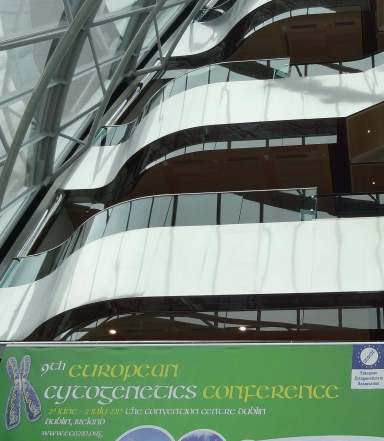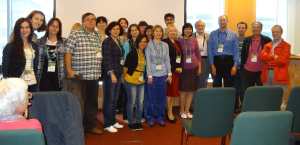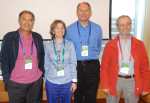
I was at ECA2013 in Dublin to discuss chromosomes. Workshops on molecular cytogenetics, array CGH, and “Plant, animal and comparative cytogenetics” were included (as well as many parallel ones on prenatal diagnostics, cancers, mutagenesis and ethics, which I could not attend), and started writing this after the opening talk by Orsetta Zaffardi from Pavia on “Microarrays, Next Generation Sequencing and Cytogenetics”.
The full abstracts are at http://link.springer.com/journal/10577/21/1/suppl/page/1 (needs subscription http://dx.doi.org/10.1007/s10577-013-9364-x ££)

The Permanent Working Group PWG on plants and animals included seven short presentations. While none of the speakers were from Ireland, three important and indeed iconic species for Ireland were discussed – the horse, basis of the huge bloodstock industry of the country, Lolium or ryegrass which underpins the €5billion Euro Irish ruminant animal industry, and Linum or flax/linseed, an iconic species with Irish linen being widely advertised (even if virtually no flax is grown in Ireland for fibre, and only a small amount of linseed for oil). Mariano Rocchi introduced the session and noted how much we had learned in the last two years about sources of variation and variability in the genome, with results coming from a huge range of species.
Svetlana Galkina (St Petersberg, Russia) opened the session with a comparison of chicken and Japanese quail genomes and karyotypes: they are separated by 35 million years of divergent evolution, but both have 2n=78, with no interchromosomal rearrangements but numerous intrachromosomal rearrangements, and major differences in genome size and repetitive DNA. In chicken- quail comparisons, her detailed analysis of CNVs (copy number variations) showed 28 losses and 59 gains, covering about 1% of the chicken genome. 25 CNVs were associated with annotated genes, and these regions were enriched in cytoskeletal/antigen and some transcription binding sites. The CNV map for Japanese quail did not correlate with phylogenetic distance when compared with the more distance turkey and duck genomes.
The next paper, by Halina Cernohorska (Brno, Czech Republic) reported X-to-autosome translocations in the antelope clade (Antilopini, Bovidae). Chromosome evolution in Bovidae is driven by Robertsonian fusions, and study of the X chromosome structure, using chromosome paints to show both transpositions of segments of chromosomes and evolution of repetitive DNA, has been critical to resolve some incongruities.
Claudia Catacchio from Bari addressed the structural variations in subtelomeric heterochromatin in gorilla and the great apes., aiming to characterize the full range of no less than 7665 structural changes in the gorilla lineage including inversions, deletions, duplications and mobile element insertions, as well as a satellite DNA. Extensive segmental duplications were found. The work is building up an important and comprehensive evolutionary model. In the discussion, Malcolm Ferguson-Smith pointed out how critical chromosome size measurements were in discovery of duplication, and how there were often incorrect genome assemblies.
The next two talks, from Petra Musilova and Jitka Krchnava from Brno, discussed aspects of site specific recombination and illegitimate t-lymphocyte interlocus recombination, comparing the situation in pigs (Petra) and horse (Jitka) with human. There were surprisingly large differences in trans-rearrangement frequencies between human (lower) and these species (higher), and even between different Equid species, perhaps reflecting the complexities of genomic structure the T cell Receptor (TR) genes in pigs and Equids. The last speaker on animal cytogenetics, Fabio Anaclerio, discussed comparative organization of the POTE Prostrate-Ovary_TEstis gene family, comprising 13 paralogues in three groups, across a number of primate species where gene structure and number of copies is varying. Comparison of results from in situ hybridization and in silico analysis also revealed some wrong assemblies in the macaque genome, and the marmoset seemed to be depleted in the gene family.
Both speakers in the plant section were discussing chromosomal organization of the rDNA genes across a number of species related to economically important crops. Vania Techio (Minas Gerais, Brazil) discussed Lolium multiflorum, annual ryegrass, where there are diploid and polyploid forms, with variation in expression and size of the 45S rDNA loci and substantial intraspecific variation. Olga Muravenko (Moskow) presented comparative karyology in the large genus Linum with 200 species; interestingly the 45S loci seemed to be on some long chromosome arms in some of the species, and she was also able to detect that karyotype evolution was accompanied by chromosome rearrangements, polyploidy and aneuploidy (raising and decreasing chromosome number).

The Animal and Plant Cytogenetics research area also had a range of excellent posters presented during the meeting. We were happy to award two ECA poster prizes for these presentations: Miluse Vozdova (Brno, Czech Republic) for a poster including impressive meiotic in situ hybridization and immunofluorescence showing a t(14;20) Robertsonian translocation that is widespread in captive-bred impalas; and Maria Florak (Wroclaw, Poland) showing relationships between oat (Avena) species and a new hybrid using in situ hybridization and molecular markers, and extending the work to study the effects of modulation of DNA methylation on rDNA expression and nucleoli.

Excellent Sir,
I pray to ALLAH ALMIGHY to bless me another chance to live and learn from you
Please the keep the pace up and up